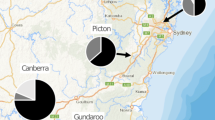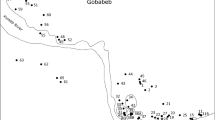Abstract
We estimated queen mating frequency, genetic relatedness among workers, and worker reproduction in Vespa crabro flavofasciata using microsatellite DNA markers. Of 20 colonies examined, 15 contained queens inseminated by a single male, 3 colonies contained queens inseminated by two males, and 2 colonies contained queens inseminated by three males. The genetic relatedness among workers was estimated to be 0.73±0.003 (mean±SE). For this high relatedness, kin selection theory predicts a potential conflict between queens and workers over male production. To verify whether males are derived from queens or workers, 260 males from 13 colonies were genotyped at four microsatellite loci. We found that all of the males were derived from the queens. This finding was further supported by the fact that only 33 of 2,990 workers dissected had developed ovaries. These workers belonged to 2 of the 20 colonies. There was no relationship between queen mating frequency and worker reproduction, and no workers produced male offspring in any of the colonies. These results suggest that male production dominated by queens in V. crabro flavofasciata is possibly due to worker policing.

Similar content being viewed by others
References
Archer ME (1992) The taxonomy of Vespa crabro L. and V. dybowskii Andre (Hym., Vespidae). Entomol Mon Mag 128:157–164
Archer ME (1993) The life history and colonial characteristics of the hornet, Vespa crabro L. (Hym., Vespidae). Entomol Mon Mag 129:151–163
Boomsma JJ, Ratnieks FLW (1996) Paternity in eusocial Hymenoptera. Philos Trans R Soc Lond B 351:947–975
Cole BJ (1983) Multiple mating and the evolution of social behaviour in the Hymenoptera. Behav Ecol Sociobiol 12:191–201
Cook JM, Crozier RH (1995) Sex determination and population biology in the Hymenoptera. Trends Ecol Evol 10:281–286
Crozier RH, Pamilo P (1996) Evolution of social insect colonies. Sex allocation and kin selection. Oxford University Press, Oxford
Daly D, Archer ME, Watts PC, Speed MP, Hughes MR, Barker FS, Jones J, Odgaard K, Kemp SJ (2002) Polymorphic microsatellite loci for eusocial wasps (Hymenoptera: Vespidae). Mol Ecol Notes 2:273–275
Foster KR, Ratnieks FLW (2000) Facultative worker policing in a social wasp. Nature 407:692–693
Foster KR, Ratnieks FLW (2001) Paternity, reproduction and conflict in vespine wasps: a model system for testing kin selection predictions. Behav Ecol Sociobiol 50:1–8
Foster KR, Seppä P, Ratnieks FLW, Thorén PA (1999) Low paternity in the hornet Vespa crabro indicates that multiple mating by queens is derived in vespine wasps. Behav Ecol Sociobiol 46:252–257
Foster KR, Ratnieks FLW, Raybould AF (2000) Do hornets have zombie workers? Mol Ecol 9:735–742
Foster KR, Ratnieks FLW, Gyllenstrand N, Thorén PA (2001) Colony kin structure and male production in Dolichovespula wasps. Mol Ecol 10:1003–1010
Foster KR, Gulliver J, Ratnieks FLW (2002) Worker policing in the European hornet Vespa crabro. Insectes Soc 49:41–44
Goodisman MAD, Matthews RW, Crozier RH (2002) Mating and reproduction in the wasp Vespula germanica. Behav Ecol Sociobiol 51:487–502
Goodnight KF, Queller DC (1994) Relatedness 4.2. Goodnight Software, Houston, Tex.
Hamilton WD (1964) The genetical theory of social behaviour I, II. J Theor Biol 7:1–52
Hasegawa E, Takahashi J (2002) Microsatellite loci for genetic researches of the hornets Vespa mandarinia and their related species. Mol Ecol Notes 2:306–308
Kikuta N, Tsuji K (1999) Queen and worker policing in the monogynous and monoandrous ant. Diacamma sp. Behav Ecol Sociobiol 46:180–189
Matsuura M, Yamane S (1990) Biology of the Vespine wasps. Springer, Berlin Heidelberg New York
Queller DC, Goodnight KF (1989) Estimating relatedness using genetic markers. Evolution 46:258–275
Ratnieks FLW (1988) Reproductive harmony via mutual policing by workers in eusocial Hymenoptera. Am Nat 132:217–236
Ratnieks FLW, Reeve HK (1992) Conflict in single-queen hymenopteran societies: the structure of conflict and processes that reduce conflict in advanced eusocial species. J Theor Biol 158:33–65
Ratnieks FLW, Visscher PK (1989) Worker policing in the honeybee. Nature 342:796–797
Ross KG (1985) Aspect of worker reproduction in four social wasp species (Insecta: Hymenoptera: Vespidae). J Zool (Lond) 205A:411–424
Ross KG (1986) Kin selection and the problem of sperm utilization in social insects. Nature 323:798–800
Starr CK (1984) Sperm competition, kinship, and sociality in the aculate Hymenoptera. In: Smith RL (ed) Sperm competition and the evolution of animal mating systems. Academic Press, Orlando, Fla., pp 427–464
Takahashi J, Akimoto S, Hasegawa E, Nakamura J (2002) Queen mating frequencies and genetic relatedness between workers in the hornet Vespa ducalis (Hymenoptera: Vespidae). Appl Entomol Zool 37:481–486
Thorén PA (1998) Mating structure and nestmate relatedness in primitively social Hymenoptera as revealed by microsatellites. PhD thesis, Uppsala University, Sweden
Walsh PS, Metzger DA, Higuchi R (1991) Chelex 100 as a medium for simple extraction of DNA for PCR-based typing from forensic material. Biotechniques 10:506–513
Yamane S (1974) Observations on an orphan nest of Vespa simillima Smith (Hymenoptera, Vespidae). Kontyû 42:404–415
Acknowledgements
We sincerely thank Prof. Mitsuo Matsuka and Dr. Masato Ono of Tamagawa University for kindly providing the Vespa suits and for helpful comments on this work. We are grateful to Dr. S. Martin of Sheffield University and Dr. Kazuki Tsuji of Ryukyu University for valuable improvements of the manuscript.
Author information
Authors and Affiliations
Corresponding author
About this article
Cite this article
Takahashi, Ji., Nakamura, J., Akimoto, Si. et al. Kin structure and colony male reproduction in the hornet Vespa crabro (Hymenoptera: Vespidae). J Ethol 22, 43–47 (2004). https://doi.org/10.1007/s10164-003-0105-z
Received:
Accepted:
Published:
Issue Date:
DOI: https://doi.org/10.1007/s10164-003-0105-z




